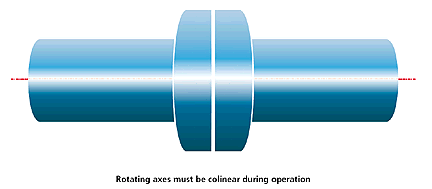For machinery installation, only the rotating shaft centerlines of different machines are aligned. Not the feet, not the coupling, not the shaft surfaces, not the machine housings, not the bearings; only the rotating shaft centerlines. It is important to understand that alignment refers to the positions of two centerlines of rotation or two rotational axes. Note that the shaft’s rotational centerline may be different than its machined centerline.
Shaft alignment means: Positioning two or more machines so that their rotational centerlines are colinear at the coupling point under operating conditions. Colinear means two lines that are positioned as if they were one line. Colinear, as used in alignment, means two or more centerlines of rotation with no offset or angularity between them.
The phrase “coupling point” in the definition of shaft alignment is an acknowledgment that vibration due to misalignment originates at the point of power transmission, the coupling. It does not mean that the couplings are being aligned. The shafts are being aligned, and the coupling center is just the measuring point.” At operating conditions” is an acknowledgment that machines often move after start-up due to wear, thermal growth, dynamic load shifts, or support structure shifts. Besides the above considerations, the term shaft alignment also implies that the bearings and shafts are free from preloads. In properly installed equipment, there are no forces or strains on the bearings and shafts, except those the designers intended. If the machine is installed with the frame distorted because of uneven or imperfect base plates, bent feet, pipe stresses, or whatever, then machine life will be shortened, often significantly. The only way to determine rotational centerlines is to rotate the equipment. There is no series of measurements that do not involve turning the shafts between readings that can be used to find the rotational centerline.
If you don’t turn the shafts…Any system that takes so-called alignment measurements without turning BOTH shafts is aligning surfaces, not centerlines of rotation. The results of any alignment efforts where one or both shafts are not turned are highly dependent upon the surface quality, rotor eccentricity, shaft straightness, and other surface defects. In short: “If you do not turn the shafts, you are not doing shaft alignment.”
Related Blog: The 12 Rights for Precision Shaft Alignment
Filed under:
Alignment by Ana Maria Delgado, CRL
